|
Frequency Domain Location in a Nutshell
- In 5G, time and frequency resource allocation of physical channels or signals are very flexible comparing to LTE
- Due to this high flexibility, it is often tricky to understand how the configuration of such frequency and time domain works.
- Time domain configuration is relatively simple since it is specified as an absolute OFDM symbol number within a slot, but frequency domain configuration is not as simple as time domain configuration.
- Explanation on how such a frequency domain allocation (frequency domain resource location) works is the main purpose of this note.
- A few important terminology you should get familiar with for frequency domain location are
- Reference Subcarrier
- PointA
- LocationAndBandwidth
- Physical Signals or Channels that are applicable to this concept are
|
Frequency Domain Location in Detail
As you know, NR use various types of subcarrier spacing (Numerology). In addition, it can use different subcarrier spacing within the same channel bandwidth depending on type of channel/signal (e.g, SSB, PDSCH etc) or BWP. Then the problem (confusing part) is how to specify the location of each resource blocks using differentsubcarrier spacing. We need some kind of reference coordinate system for this.
In NR, there are two different type of reference coordinate system and these reference coordinate system is called Reference PRB. In sub 6 Ghz(FR1), we use the reference PRB system based on 15 Khz subcarrier spacing and in mmWave(FR2) we use the reference PRB sysbem based on on 60 khz subcarrier spacing as illustrated below.
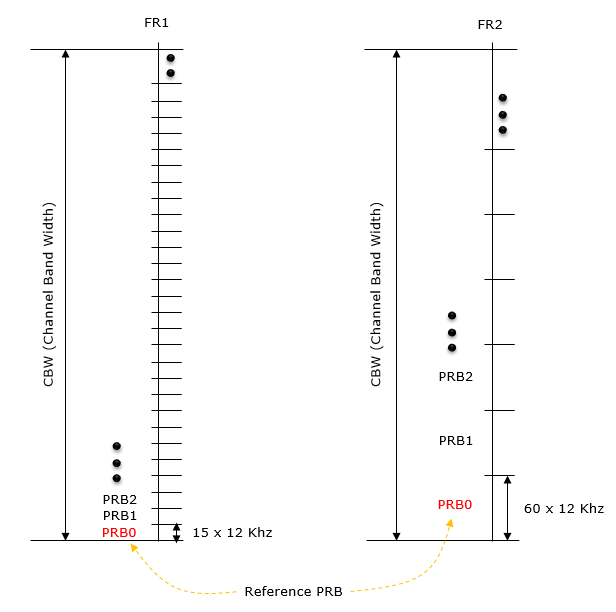
This kind of common reference point shown above is represented as a specific term named as 'PointA' in 3GPP. The PointA is defined in 38.211 - 4.4.4.2 as follows.
For example, let's assume that we configure SSB with 30 Khz subcarrier spacing in FR1. We can configure the frequency domain location of SSB in Reference PRB coordinate as shown below and the position can be informed to UE via signaling message.
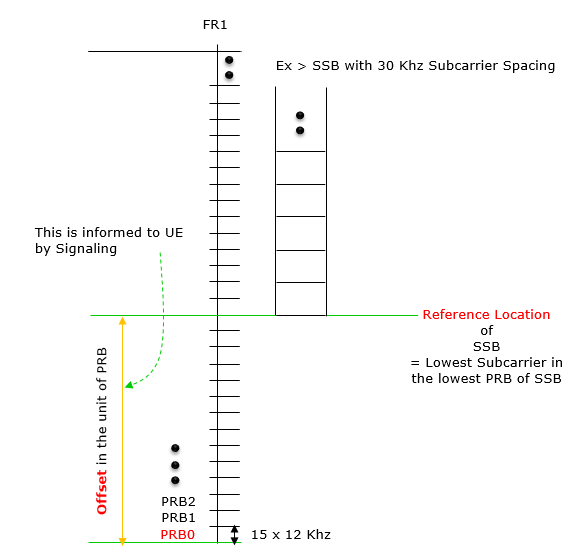
The illustration shown below is based on the following statement on absoluteFrequencySSB from 38.331. As you may notice, there is slight differences between the two versions. The biggest difference is the part in red. The illustration shown below is based on v15.2.1.
38.331 V15.2.1 (2018-06)
Frequency of the SSB to be used for this serving cell. The frequency provided in this field identifies the position of resource element RE=#0 (subcarrier #0) of resource block RB#10 of the SS block. The cell-defining SSB of the PCell is always on the sync raster. Frequencies are considered to be on the sync raster if they are also identifiable with a GSCN value (38.101). If the field is absent, the SSB related parameters should be absent, e.g. ssb-PositionsInBurst,
ssb-periodicityServingCell
and subcarrierSpacing in ServingCellConfigCommon IE. If the field is absent, the UE obtains timing reference from the SpCell. This is only supported in case the Scell is in the same frequency band as the SpCell.
38.331 V15.5.1 (2019-05)
Frequency of the SSB to be used for this serving cell. SSB related parameters (e.g. SSB index) provided for a serving cell refer to this SSB frequency unless mentioned otherwise. The cell-defining SSB of the PCell is always on the sync raster. Frequencies are considered to be on the sync raster if they are also identifiable with a GSCN value(TS 38.101-1). If the field is absent, the SSB related parameters should be absent, e.g. ssb-PositionsInBurst, ssb-periodicityServingCell and subcarrierSpacing
in ServingCellConfigCommon IE. If the field is absent, the UE obtains timing reference from the SpCell. This is only supported in case the Scell is in the same frequency band as the SpCell.
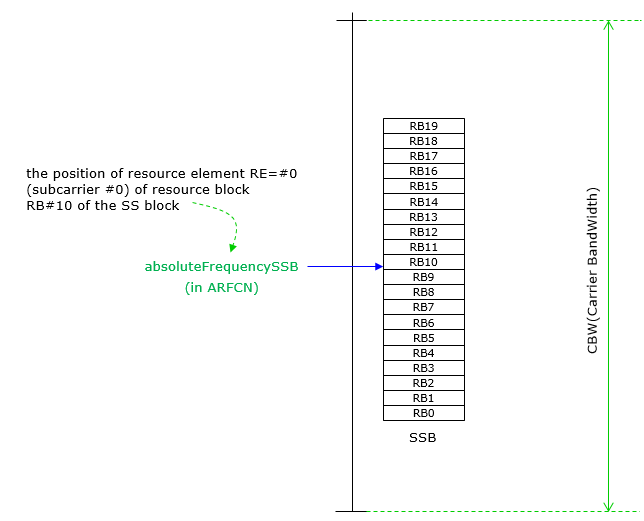
PointA is defined in 38.211 - 4.4.4.2 as follows.
- Point A serves as a common reference point for resource block grids and is obtained from:
- offsetToPointA for a PCell downlink represents the frequency offset between point A and the lowest subcarrier of the lowest resource block of the SS/PBCH block used by the UE for initial cell selection, expressed in units of resource blocks assuming 15 kHz subcarrier spacing for FR1 and 60 kHz subcarrier spacing for FR2;
- absoluteFrequencyPointA for all other cases where absoluteFrequencyPointA represents the frequency-location of point A expressed as in ARFCN.
AbsoluteFrequencyPointA is defined by 38.331 (v15.7) as follow.
Absolute frequency position of the reference resource block (Common RB 0). Its lowest subcarrier is also known as Point A . Note that the lower edge of the actual carrier is not defined by this field but rather in the scs-SpecificCarrierList.
GSCN is with reference to the center frequency of SSB based on the statement in 38.104 - 5.4.3.2.
The mapping between the synchronization raster and the corresponding resource element of the SS block is given in table 5.4.3.2-1. The mapping depends on the total number of RBs that are allocated in the channel and applies to both UL and DL.
< 38.104 v15.7 - Table 5.4.3.2-1: Synchronization Raster to SS block Resource Element Mapping >

I assume that both GCSN and SSB_REF are with the reference to the center frequency of SSB based on the statement in 38.104 - 5.4.3.2.
The frequency position of the SS block is defined as SS_REF with corresponding number GSCN. The parameters defining the SSREF and GSCN for all the frequency ranges are in table 5.4.3.1-1
< 38.104 v15.7 - Table 5.4.3.1-1: GSCN parameters for the global frequency raster >

Putting all the statements mentioned above, I can illustrate the SSB position and PointA, OffsetToPointA,ssb-subcarrierOffset as follows.
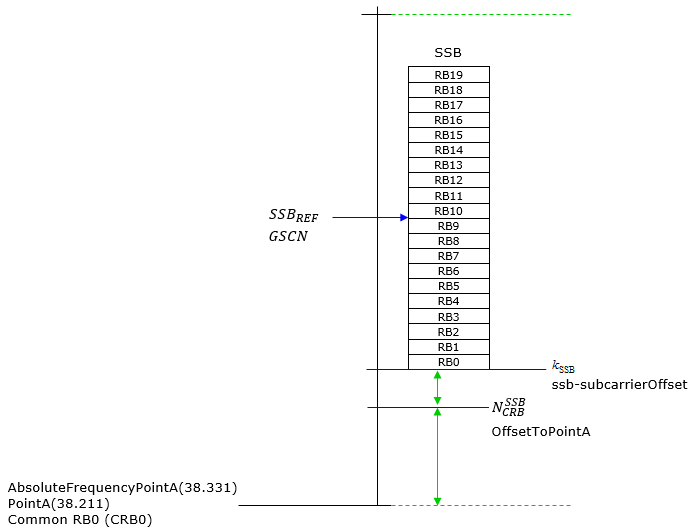
Example 01 > PointA Calculation for SCS 30Khs
Assuming followings are given
(1) GSCN (ARFCN)
(2) k_SSB
(3) OffsetToPointA
Step 1 : Convert (1) into the frequency in Mhz and assign it to (A)
Step 2 : Calculate the SSB Reference Location(subcarrier 0 in RB0 of SSB) in Mhz and store it to (B)
(B) = (A) - (10 x 12 x 0.03)
NOTE : : (10 x 12 x 0.03) indicates 10 RB(half of total SSB RB) in Mhz
Step 3 : Calculate Point A in the form of frequency in Mhz using following equation and assign it to (C)
(C) = (B) - (k_SSB x 0.015) - ((3) x 12 x 0.015)
NOTE : : 0.015 in (k_SSB x 0.015) came from here.
Step 4 : Convert (C) into ARFCN
NOTE : The calculation in this example is based on the following statement.
38.211-4.4.4.2 states 'offsetToPointA for a PCell downlink represents the frequency offset between point A and the lowest subcarrier of the lowest resource block overlapping with the SS/PBCH block used by the UE for initial cell selection, expressed in units of resource blocks assuming 15 kHz subcarrier spacing for FR1 and 60 kHz subcarrier spacing for FR2'.
Example 02 > PointA Calculation for SCS 30Khs
Now let's practice the example 1 with concrete numbers. Let's assume that we are given following numbers
Step 1 : Convert (1) into the frequency in Mhz and assign it to (A)
GSCN (ARFCN) = 7811 (629952) ==> 3449.28 Mhz
NOTE : I used this site to get this number
Step 2 : Calculate the SSB Reference Location(subcarrier 0 in RB0 of SSB) in Mhz and store it to (B)
(B) = (A) - (10 x 12 x 0.03)
= 3449.28 - (10 x 12 x 0.03)
= 3445.68
Step 3 : Calculate Point A in the form of frequency in Mhz using following equation and assign it to (C)
(C) = (B) - (k_SSB x 0.015) - ((3) x 12 x 0.015)
= 3445.68 - (0 x 0.015) - (30 x 12 x 0.015)
= 3440.28
Step 4 : Convert (C) into ARFCN
The CORESET 0 Location in frequency domain is determined based on following statement in 38.213.
The offset in Tables 13-1 through 13-10 is defined with respect to the SCS of the CORESET for Type0-PDCCH CSS set, provided by subCarrierSpacingCommon, from the smallest RB index of the CORESET for Type0-PDCCH CSS set to the smallest RB index of the common RB overlapping with the first RB of the corresponding SS/PBCH block
NOTE : Note that the subcarrier spacing in the parameters shown here differs depending on the situation as summarized below.
- k_ssb : always 15 Khz subcarrier spacing for FR1, 60 Khz subcarrier spacing for FR2 regardless of SSB subcarrier spacing.
- OffsetToPointA : the unit of this parameter is number of RB. Subcarrier spacing within this RB is always 15 Khz subcarrier spacing for FR1, 60 Khz subcarrier spacing for FR2 regardless of SSB subcarrier spacing.
- SSB Subcarrier Spacing : this varies depending on subCarrierSpacingCommon value in MIB. It can be summarized as follows.
- When subCarrierSpacingCommon = scs15or60,
- SSB Subcarrier Spacing for FR1 = 15 Khz
- SSB Subcarrier Spacing for FR2 = 60 Khz
- When subCarrierSpacingCommon = scs30or120,
- SSB Subcarrier Spacing for FR1 = 30 Khz
- SSB Subcarrier Spacing for FR2 = 120 Khz
Based on this statement, I illustrate the CORESET 0 position as shown below.
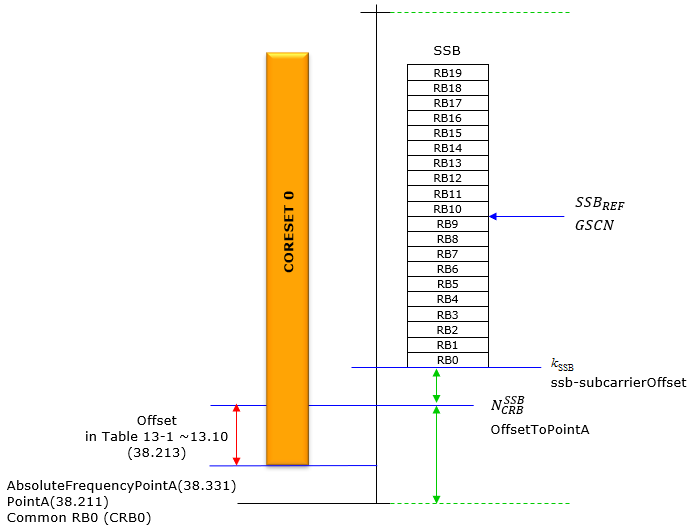
The location and size of a BWP are specified in the RRC (Radio Resource Control) layer using several parameters, including AbsoluteFrequencyPointA, LocationAndBandwidth
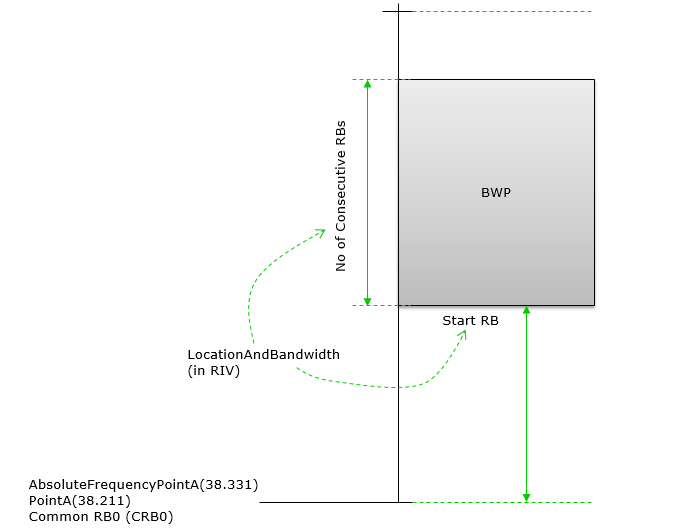
As illustrated above, BWP location is specified by two parameters : AbsoluteFrequencyPointA and LocationAndBandwidth. Brief description of these two parameters are :
- AbsoluteFrequencyPointA: This parameter defines the absolute frequency of the first subcarrier in the lowest frequency band of the common resource blocks (CRBs) in the channel band.
- LocationAndBandwidth: This parameter is used to define both the location(starting position) and the bandwidth of the BWP. It is encoded using a single integer value which is calculated from the two values (i.e, startRB and lcrb(the number of contiguous RBs)).
NOTE : For further details and specific examples on how to calculate LocationAndBandwidth, refer to this.
There are many different RRC parameters determining Frequency Domain Location as listed below. But not all of them are used all at the same time. Depending on situation, the different set of parameters are used. When you try to set these frequency related parameters, you may ask to yourself a few questions as below.
- Do I want to setup frequency configuration in NSA or SA ?
- Do I want to setup SSB frequency ? or BWP frequency ?
FrequencyInfoDL ::= SEQUENCE {
absoluteFrequencySSB ARFCN-ValueNR,
frequencyBandList MultiFrequencyBandListNR,
absoluteFrequencyPointA ARFCN-ValueNR,
scs-SpecificCarrierList SEQUENCE (SIZE (1..maxSCSs)) OF SCS-SpecificCarrier,
...
}
SCS-SpecificCarrier ::= SEQUENCE {
offsetToCarrier INTEGER (0..2199),
subcarrierSpacing SubcarrierSpacing,
carrierBandwidth INTEGER (1..maxNrofPhysicalResourceBlocks),
...,
[[
txDirectCurrentLocation-v1530 INTEGER (0..4095) OPTIONAL -- Need S
]]
}
FrequencyInfoDL-SIB ::= SEQUENCE {
frequencyBandList MultiFrequencyBandListNR-SIB,
offsetToPointA INTEGER (0..2199),
scs-SpecificCarrierList SEQUENCE (SIZE (1..maxSCSs)) OF SCS-SpecificCarrier
}
MIB ::= SEQUENCE {
systemFrameNumber BIT STRING (SIZE (6)),
subCarrierSpacingCommon ENUMERATED {scs15or60, scs30or120},
ssb-SubcarrierOffset INTEGER (0..15),
dmrs-TypeA-Position ENUMERATED {pos2, pos3},
pdcch-ConfigSIB1 INTEGER (0..255),
cellBarred ENUMERATED {barred, notBarred},
intraFreqReselection ENUMERATED {allowed, notAllowed},
spare BIT STRING (SIZE (1))
}
absoluteFrequencySSB : Frequency of the SSB to be used for this serving cell. SSB related parameters (e.g. SSB index) provided for a serving cell refer to this SSB frequency unless mentioned otherwise. The frequency provided in this field identifies the position of resource element RE=#0 (subcarrier #0) of resource block RB#10 of the SS block. The cell-defining
SSB of the PCell is always on the sync raster. Frequencies are considered to be on the sync raster if they are also identifiable with a GSCN value. If the field is absent, the SSB related parameters should be absent, e.g. ssb-PositionsInBurst, ssb-periodicityServingCell and subcarrierSpacing in ServingCellConfigCommon IE. If the field is absent, the UE obtains timing reference from the SpCell. This is only supported in case the Scell is in the same frequency
band as the
SpCell => The value in this field in in the unit of ARFCN
absoluteFrequencyPointA : Absolute frequency position of the reference resource block (Common RB 0). Its lowest subcarrier is also known as Point A. Note that the lower edge of the actual carrier is not defined by this field but rather in the scs-SpecificCarrierList. Corresponds to L1 parameter 'offset-ref-low-scs-ref-PRB'
=> The value in this field in in the unit of ARFCN
carrierBandwidth : Width of this carrier in number of PRBs (using the subcarrierSpacing defined for this carrier) Corresponds to L1 parameter 'BW => The value in this field in in the unit of RB
offsetToCarrier : Offset in frequency domain between Point A (lowest subcarrier of common RB 0) and the lowest usable subcarrier on this carrier in number of PRBs (using the subcarrierSpacing defined for this carrier). The maximum value corresponds to 275*8-1. Corresponds to L1 parameter 'offset-pointA-low-scs'
SubcarrierSpacing : Subcarrier spacing of this carrier. It is used to convert the offsetToCarrier into an actual frequency. Only the values 15 or 30 kHz (<6GHz), 60 or 120 kHz (>6GHz) are applicable. The network configures all SCSs of configured BWPs configured in this serving cell. Corresponds to
L1 parameter 'ref-scs'
txDirectCurrentLocation : Indicates the downlink Tx Direct Current location for the carrier. A value in the range 0..3299 indicates the subcarrier index within the carrier. The values in the value range 3301..4095 are reserved and ignored by the UE. If this field is absent, the UE assumes the default value
of 3300 (i.e. "Outside the carrier").
offsetToPointA : The offset in PRB between the Point A and the lowest subcarrier of the lowest PRB of the cell-defining SSB after floating SSB is resolved.
38.211-4.4.4.2 states 'offsetToPointA for a PCell downlink represents the frequency offset between point A and the lowest subcarrier of the lowest resource block overlapping with the SS/PBCH block used by the UE for initial cell selection, expressed in units of resource blocks assuming 15 kHz subcarrier spacing for FR1 and 60 kHz subcarrier spacing for FR2'.
Reference
[1] NR Wide Bandwidth Operations by Jeongho Jeon, Intel Corporation
|







